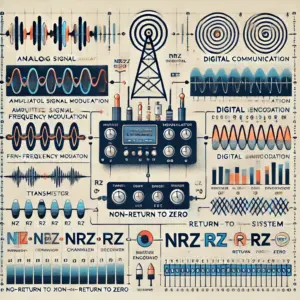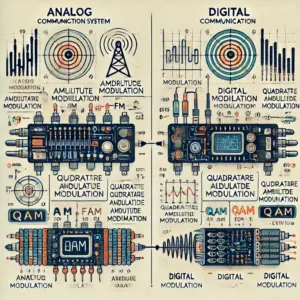ADC Notes Pdf – Analog and Digital Communication JNTU Free Lecture Notes
Here you can download the free lecture Notes of Analog and Digital Communication Notes – ADC Pdf Notes materials with multiple file links to download. This Analog and Digital Communication Notes Pdf book/Material starts with the topics covering Analog communication, Digital communication, Data and pulse communication, Source and error control coding, Multi-User Radio Communication, etc.

Analog and Digital Communication Notes Pdf – ADC pdf – ADC notes pdf file to download are listed below please check it –
Note: These Analog and Digital Communication Pdf Notes – ADC Notes are according to the R09 Syllabus book of JNTU.In R13 and R15,8-units of R09 syllabus are combined into 5-units in R13 and R15 syllabus. If you have any doubts please refer to the JNTU Syllabus Book.
Note: These Analog and Digital Communication Notes – ADC Notes are according to the r09 Syllabus book of JNTUH. In R13 ,8-units of R09 syllabus are combined into 5-units in r13 syllabus.Click here to check all the JNTU Syllabus books.
Analog and Digital Communication Notes Pdf – ADC Pdf Notes
The field of communication engineering has undergone significant transformations, primarily driven by advancements in technology that facilitate more efficient and reliable ways of transmitting information. Analog and Digital Communication is a fundamental course in this discipline, essential for understanding how information is conveyed over different mediums. These notes are structured to provide comprehensive coverage of Analog and Digital Communication, tailored to the JNTU syllabus, making them indispensable for B.Tech students.
Analog and Digital Communication | PDF, Syllabus, Books | B Tech (2025)
Analog and Digital Communication encompasses various methods and technologies used to transfer data over distances. This course covers critical aspects of both analog and digital transmission, including the theory, application, and technologies involved. From basic principles to advanced topics, these notes offer a robust framework for students aiming to master communication systems.
The notes are organized into five units, aligned with the revised JNTU syllabus, ensuring that students receive a holistic and in-depth understanding of both analog and digital communication systems.
The following topics are covered in Analog and Digital Communication Handwritten Notes
Unit 1: Analog and Digital Communication Basics
- Analog Communication:
This section introduces the principles of analog communication, where information is transmitted using continuous signals. It covers essential concepts such as amplitude modulation, frequency modulation, and phase modulation. - Noise and Its Effects on Signals:
Noise is an unwanted disturbance that affects signal quality. This topic explores various types of noise, including internal noise (thermal, shot, flicker noise) and external noise (atmospheric, extraterrestrial, man-made noise), and their impact on signal integrity. - Correlated and Uncorrelated Signals:
Understanding the distinction between correlated and uncorrelated signals is crucial for effective noise reduction and signal processing. This section delves into techniques for analyzing and mitigating noise in communication systems. - Need for Modulation:
Modulation is the process of varying a carrier signal to transmit information. This topic explains the need for modulation in communication systems, including improving signal-to-noise ratio, enabling multiplexing, and facilitating long-distance transmission. - Types of Modulation:
Different modulation techniques, such as amplitude modulation (AM), frequency modulation (FM), and phase modulation (PM), are explored, along with their applications and advantages.
Unit 2: Digital Communication Techniques
- Digital Communication:
This section covers the fundamentals of digital communication, where information is transmitted using discrete signals. The advantages and disadvantages of digital communication over analog communication are discussed. - Need for Digital Modulation:
Digital modulation techniques are essential for efficient data transmission. This topic explores the reasons for using digital modulation, including improved noise immunity, bandwidth efficiency, and compatibility with digital systems. - Basic Encoding Techniques or Digital Modulation Techniques:
This section introduces various digital modulation techniques, such as amplitude shift keying (ASK), frequency shift keying (FSK), and phase shift keying (PSK), explaining their principles and applications. - Amplitude Shift Keying (ASK):
ASK is a modulation technique where the amplitude of the carrier signal is varied to represent binary data. This topic covers the operation of coherent and non-coherent ASK detectors and their applications. - Frequency Shift Keying (FSK):
FSK involves varying the frequency of the carrier signal to transmit data. This section explains FSK modulation and demodulation processes, including FSK transmitters and receivers, and their applications in communication systems. - Binary Phase Shift Keying (BPSK):
BPSK is a digital modulation technique where the phase of the carrier signal is varied to represent binary data. This topic covers the operation of BPSK transmitters, modulated waveforms, and phasor diagrams.
Unit 3: Data and Pulse Communication
- Data Communication Networks:
Data communication networks enable the transmission of digital data between devices. This section explores the history, components, and architectures of data communication networks. - Standard Organizations for Data Communication:
Standardization is crucial for interoperability in data communication. This topic covers major organizations such as the International Organization for Standardization (ISO), the International Telecommunication Union (ITU), and the Institute of Electrical and Electronics Engineers (IEEE). - Pulse Code Modulation (PCM):
PCM is a digital representation of analog signals. This section explains the principles of PCM, including sampling, quantization, and encoding, and its applications in digital communication systems. - Applications of Data Communication:
The section discusses various applications of data communication, including telephony, internet services, video conferencing, and online gaming, highlighting the impact of data networks on modern communication.
Unit 4: Source and Error Control Coding
- Source Coding:
Source coding involves compressing data to reduce redundancy. This topic covers techniques like Huffman coding and Shannon’s source coding theorem, which ensure efficient data representation. - Error Control Coding:
Error control coding detects and corrects errors in data transmission. This section explores different coding techniques, such as parity checks, block codes, and convolutional codes, used to enhance data reliability. - Channel Capacity Theorem:
The channel capacity theorem, formulated by Claude Shannon, defines the maximum rate at which data can be transmitted over a channel without error. This topic covers the mathematical basis and implications of the theorem. - Channel Models:
Understanding different channel models is essential for analyzing communication systems. This section explores models like the Binary Erasure Channel (BEC) and Binary Symmetric Channel (BSC), and their applications. - AWGN Channel:
The Additive White Gaussian Noise (AWGN) channel is a common model used to simulate the effect of noise in communication systems. This topic explains the characteristics and analysis of the AWGN channel.
Unit 5: Multi-User Radio Communication
- Multi-User Radio Communication:
Multi-user communication systems enable simultaneous communication among multiple users. This section explores technologies like Code Division Multiple Access (CDMA) and Time Division Multiple Access (TDMA). - Global System for Mobile Communications (GSM):
GSM is a standard for mobile communication. This topic covers the architecture, services, and functioning of GSM, highlighting its role in enabling global mobile connectivity. - Mobile Station and Base Station Controller:
Understanding the components of a mobile communication system, such as the mobile station and base station controller, is crucial for analyzing GSM networks. This section explains their roles and interactions. - Network and Switching Subsystem:
The network and switching subsystem is responsible for routing calls and managing network resources. This topic covers its components and functions in a GSM network. - Mobile Services Switching Center:
The mobile services switching center is a critical component in mobile networks, managing call setup, routing, and billing. This section explores its role and operations in a GSM network.


Links to Download ADC Notes Pdf
ADC Notes and Study Material PDF Free Download
The ADC Notes Pdf offers a comprehensive guide to understanding the principles and applications of analog and digital communication. These notes provide detailed explanations, diagrams, and examples to enhance students’ learning experiences and facilitate their academic success.
Topics Covered in this ADC Notes Pdf
The ADC Notes Pdf covers essential topics such as analog communication, digital modulation, data communication networks, source and error control coding, and multi-user radio communication. These topics are integral to understanding the technologies and techniques used in modern communication systems.
ADC Notes Pdf from JNTU
These notes are meticulously prepared to align with the JNTU syllabus, providing structured content that supports students in their academic pursuits. The notes are designed to help students master the concepts of analog and digital communication, enabling them to excel in their studies and careers.
DOWNLOAD NOW
Always Choose Smartzworld to Download ADC Notes PDF
Smartzworld is a trusted platform for accessing high-quality educational resources. By choosing Smartzworld, students gain access to reliable, accurate, and comprehensive study materials that support their learning and academic achievements.
Benefits of FREE ADC Handwritten Notes PDF
- Concise and Clear Presentation of Complex Topics:
The handwritten notes offer clear explanations of complex concepts, making it easier for students to understand the material. - Aligns with the JNTU Curriculum for Better Preparation:
The notes are tailored to the JNTU syllabus, ensuring that students are well-prepared for exams and assessments. - Free Access to Quality Educational Resources:
Students can download the notes for free, providing access to valuable study materials without financial barriers. - Easy Download and Offline Access for Continuous Learning:
The notes are available for download in PDF format, allowing students to access the material offline and study at their convenience.
Frequently Asked Questions (FAQs)
Q1: Where can I download the Analog and Digital Communication Notes Pdf?
- You can download the notes from the provided links for each unit or the complete set from Smartzworld.
Q2: How to download the ADC Notes Pdf?
- Click on the provided links to access the PDF files for each unit or the complete notes set.
Q3: How many modules are covered in ADC Notes Pdf?
- The ADC Notes Pdf covers five modules, each corresponding to a unit in the JNTU syllabus.
Q4: Topics Covered in ADC Notes Pdf?
- The notes cover analog communication, digital modulation, data networks, source coding, error control coding, and multi-user communication.
Q5: Where can I get the complete ADC Handwritten Notes pdf FREE Download?
- You can download the complete handwritten notes for free from Smartzworld or the provided links above.
Q6: How to download ADC Handwritten Notes pdf?
- Visit Smartzworld or use the download links provided to access the PDF files.
Q7: How to Download FREE ADC Notes PDF?
- Simply click on the download links provided in this article to get your free copy of the ADC notes.
Conclusion
The Analog and Digital Communication Notes Pdf is an invaluable resource for students pursuing B.Tech at JNTU. By providing detailed coverage of key topics, these notes support students in mastering the principles and applications of communication systems. With comprehensive explanations, practical examples, and easy access to study materials, students are well-equipped to excel in their studies and future careers in the communication engineering field.


